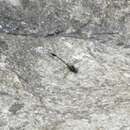pt-BR
nomes no trilho de navegação


Gwas neidr o deulu'r Gomphidae (neu'r 'Gweision neidr tindrom') yw'r Burmagomphus laidlawi. Fel llawer o weision neidr, ei gynefin yw pyllau o ddŵr, llynnoedd, nentydd neu afonydd.
Gwas neidr o deulu'r Gomphidae (neu'r 'Gweision neidr tindrom') yw'r Burmagomphus laidlawi. Fel llawer o weision neidr, ei gynefin yw pyllau o ddŵr, llynnoedd, nentydd neu afonydd.
Burmagomphus laidlawi[2] is a species of dragonfly in the family Gomphidae. It is known only from the high altitude regions of Western Ghats of India.[3][1]
It is a medium-sized dragonfly with bottle-green eyes. Its thorax is black, marked with greenish-yellow ante-humeral stripes. Sides are greenish-yellow, marked with two narrow black stripes. Wings are transparent, slightly tinted with yellow at bases. Abdomen is black, marked with yellow. Segment 1 and 2 have broad dorsal stripes, and its sides. Segment 3 has a mid-dorsal carina of yellow, and a large baso-lateral spot. Segment 4 to 6 have basal dorsal triangular spots and baso-lateral lunules. Segment 7 has a broad basal ring. Segment 8 is unmarked. Segment 9 has its apical half yellow. Segment 10 is unmarked. Anal appendages are black. Female is similar to the male.[4]
It breeds in montane forest streams and rivers.[4][5][6][7][8]
Burmagomphus laidlawi is a species of dragonfly in the family Gomphidae. It is known only from the high altitude regions of Western Ghats of India.
Burmagomphus laidlawi is een libellensoort uit de familie van de rombouten (Gomphidae), onderorde echte libellen (Anisoptera).[2]
De soort staat op de Rode Lijst van de IUCN als onzeker, beoordelingsjaar 2010.[1]
De wetenschappelijke naam van de soort is voor het eerst geldig gepubliceerd in 1924 door Fraser.
Bronnen, noten en/of referentiesBurmagomphus laidlawi – gatunek ważki z rodzaju Burmagomphus należącego do rodziny gadziogłówkowatych.
Burmagomphus laidlawi – gatunek ważki z rodzaju Burmagomphus należącego do rodziny gadziogłówkowatych.
Burmagomphus laidlawi là loài chuồn chuồn trong họ Gomphidae. Loài này được Fraser mô tả khoa học đầu tiên năm 1924.[1]
Burmagomphus laidlawi là loài chuồn chuồn trong họ Gomphidae. Loài này được Fraser mô tả khoa học đầu tiên năm 1924.